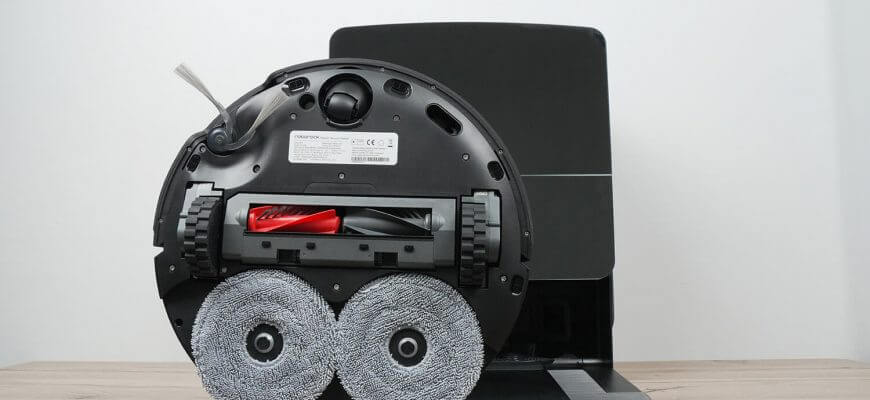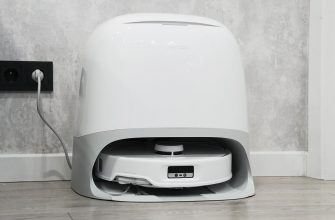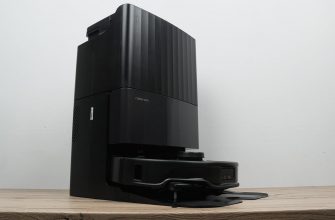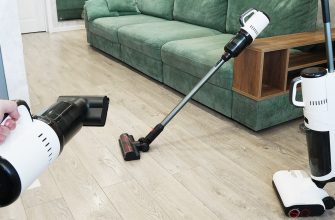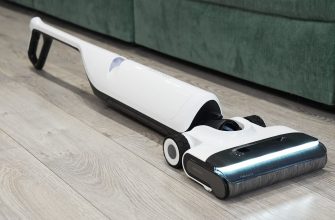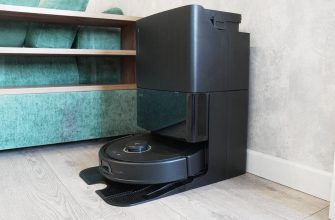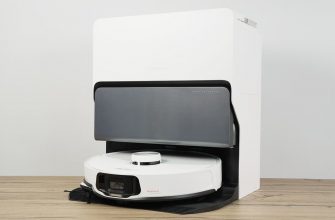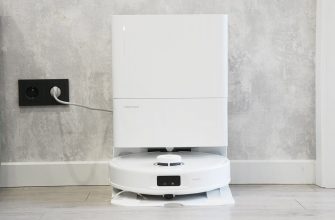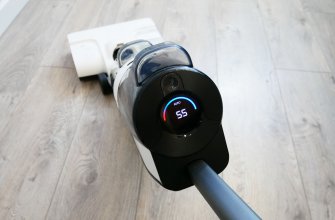Hey guys, welcome to RobotObzor! In this review, we’ll be taking a look at this year’s new release – the Roborock Saros 10R robot vacuum cleaner. Its price is 1600$. For that price, you’re getting a fully automated cleaning system with 20,000 Pa suction power, a body height of just 8 cm (3.15 inches), an extending side brush, an extending wipe, and a turbo brush that won’t get tangled with hair, along with a new navigation system and an upgraded station. The engineers have made a lot of changes, so everything needs to be put to the test to see if this robot is truly a breakthrough. Below, I’ll be testing the Roborock Saros 10R in detail, going over the strengths and weaknesses found during testing, and sharing my personal thoughts on it. Don’t forget to like and subscribe, and let’s get rolling!
Amazon: https://amzn.to/3R1qjWB
- Kit
- Appearance
- Technical Features
- Functionality
- Testing
- Navigation
- Going Under Low Furniture
- Autonomy
- Object Recognition on the Floor
- Cleaning Behind Curtains
- Suction power
- Vacuuming
- Carpet cleaning
- Self-cleaning
- Mopping and carpets
- Dirt scrubbing
- Scrubbing difficult stains
- Washing quality of mopping pads
- Station maintenance
- Obstacles
- Going over dark areas
- Volume
- Opinion
Kit
The package for this new model is standard and includes the robot vacuum cleaner with its station, power adapter, two holders with cloths, a spare bag for the station, and an instruction manual.
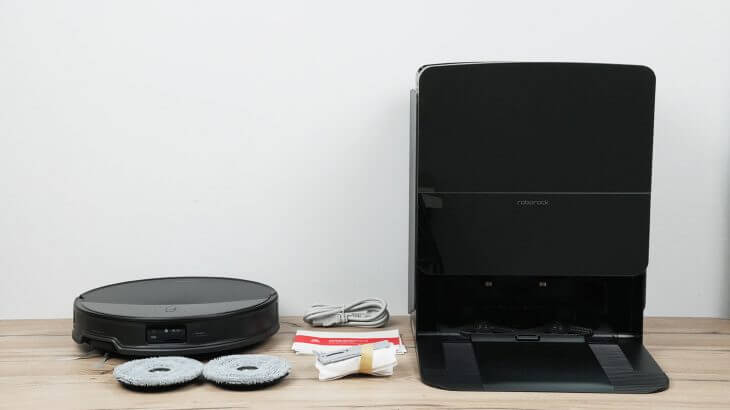
Appearance
Now, let’s take a closer look at how the Roborock Saros 10R is put together. It’s round and black. The name “Saros” comes from an astronomical term for the cycle of solar and lunar eclipses. The idea is that, just like eclipses, which are reliable and cyclical, Roborock is continuously pushing forward with innovation.
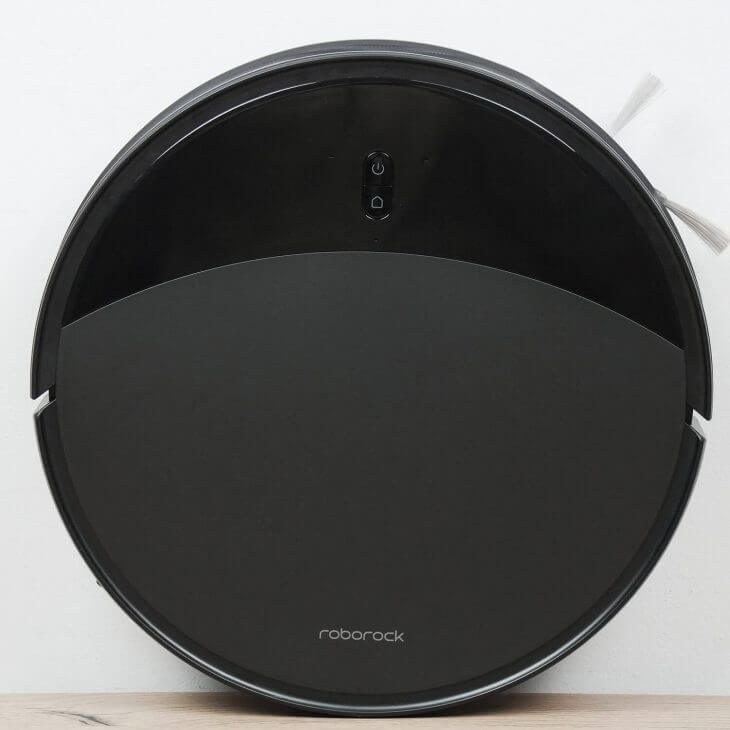
The robot vacuum cleaner stands at just 7.98 cm (3.14 inches) tall.
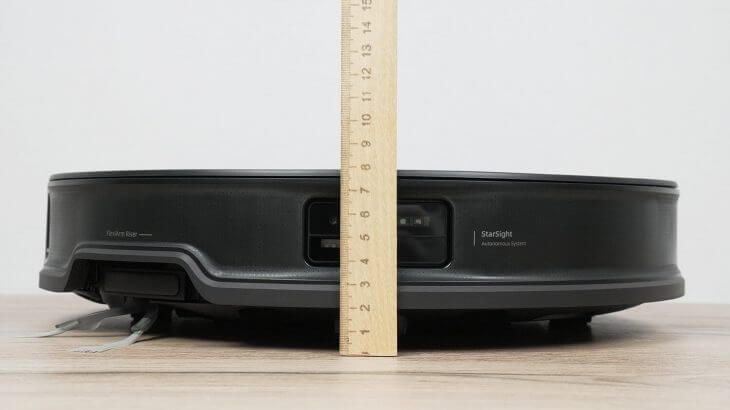
This was achieved by completely redesigning the navigation system. Instead of the usual lidar, the Roborock Saros 10R has a system of sensors and cameras called StarSight Autonomous System 2.0. This includes an object recognition system with built-in lighting on the front bumper, along with sensors and cameras positioned near the self-cleaning dirt container.
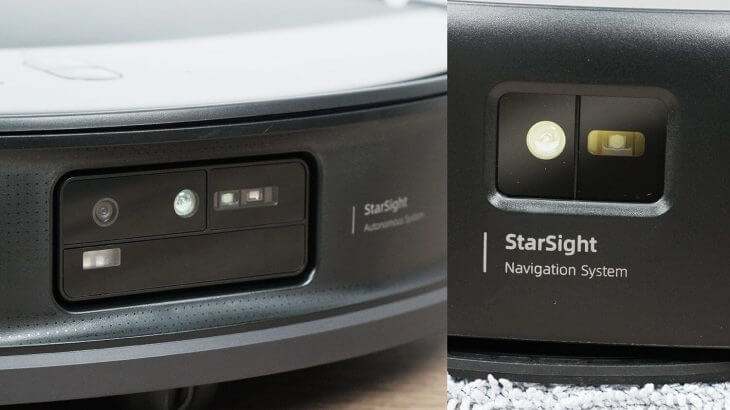
Additionally, the robot features an active camera for remote home monitoring.

Continuing with the sensors, the robot has a wall sensor, five anti-fall sensors, a carpet sensor, and a new optical sensor is made to more accurately avoid wires on the floor.
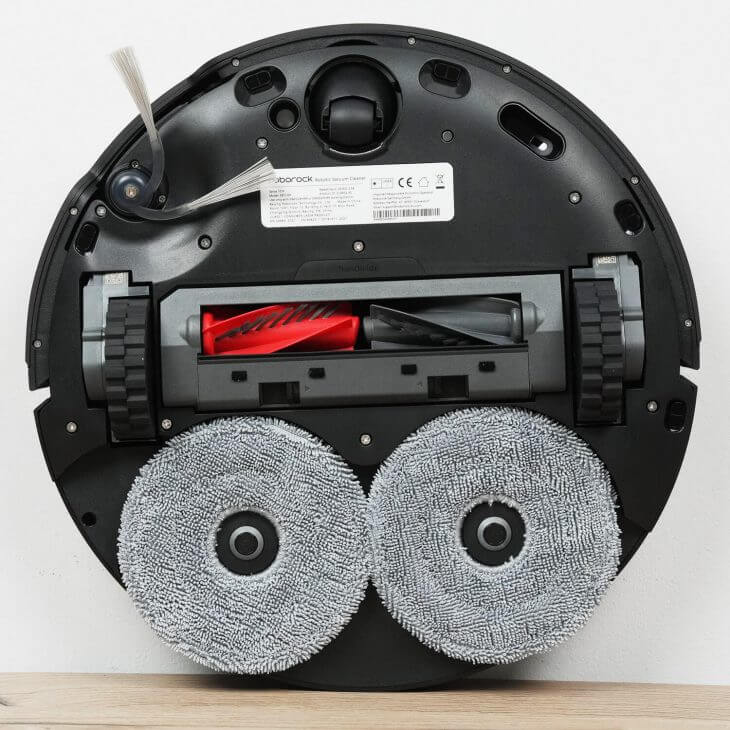
On top of the body, there are two mechanical control buttons and three speakers for the built-in “Hello, Rocky” assistant.
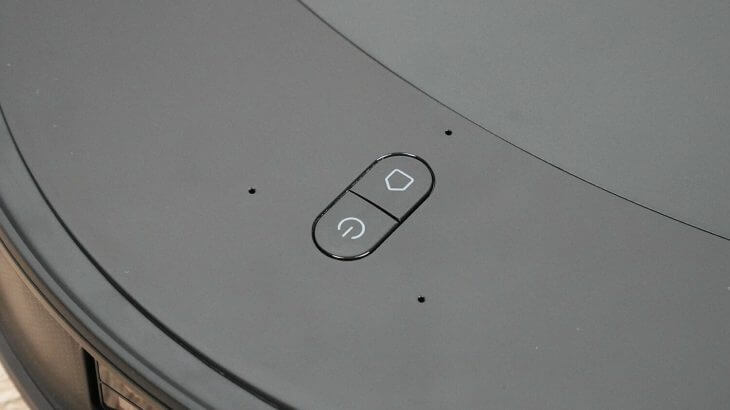
The dust collector is placed under the top cover, which is held on by magnets. Both the dust collector and the filter can be washed with water. The filtration system consists of HEPA and mesh-based filters.
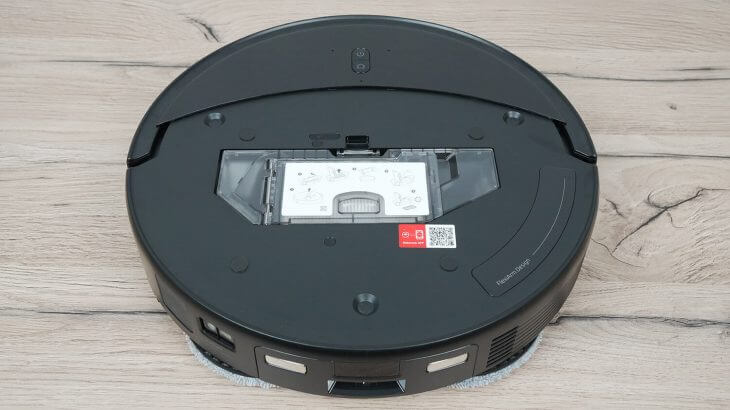
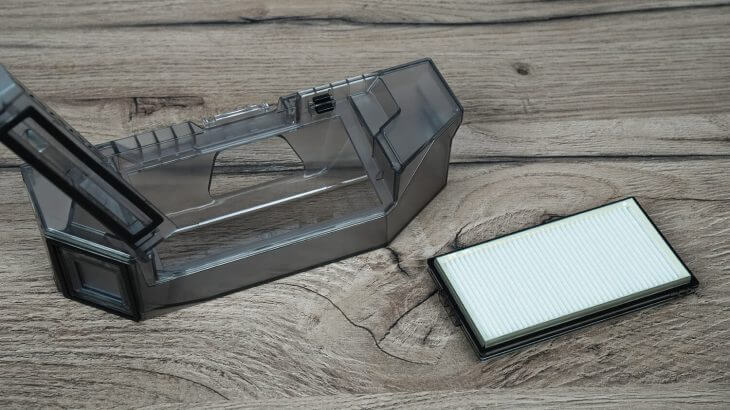
A hidden water tank is also built into the robot. Water is pumped inside automatically at the station through a nozzle positioned between the charging terminals.
The side brush is a single three-beam brush, secured with a screw. It reachesinto corners to sweep out dirt and automatically lifts when the robot drives onto carpets, enters floor washing mode, or returns to the station.
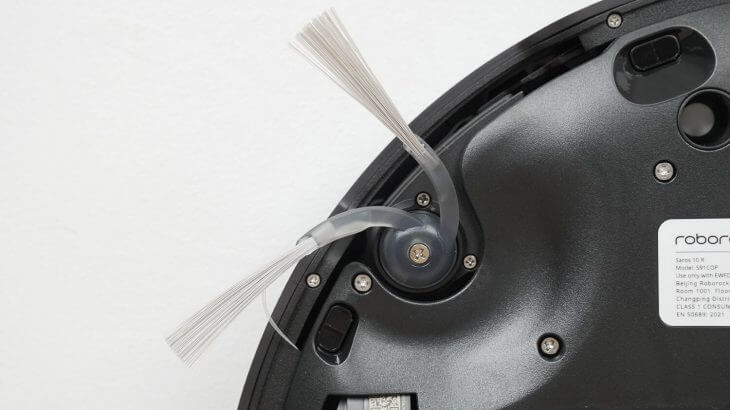
The central brush is similar to the one found on the previously released Roborock Qrevo Curv. It consists of two bristle-bladed half brushes with a center gap between them. The brush assembly is floating, and each part can be disassembled. Coiled hair and fur collect in the gap. The turbo brush lifts in floor cleaning mode, when moving over obstacles, and when the robot returns to the station.
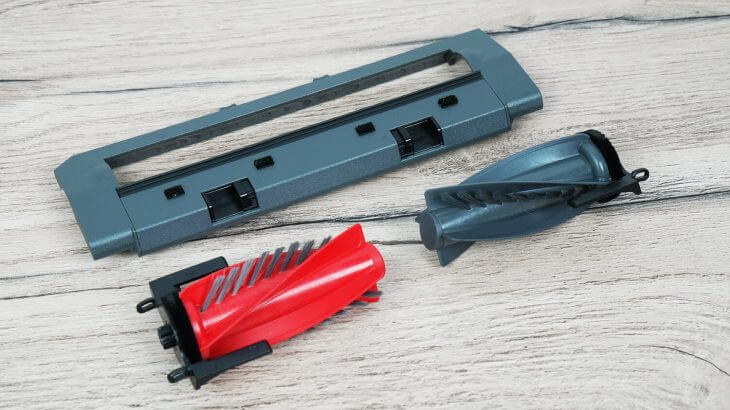
Behind the center brush are two rotating round mopping pads, one of which reaches toward the baseboard during mopping.

The mopping pads also have an automatic lifting function, and for the first time in Roborock, the holders with cloths can be automatically removed at the station. The robot can drop the holders for full vacuuming and carpet cleaning, then reattach them on its own.
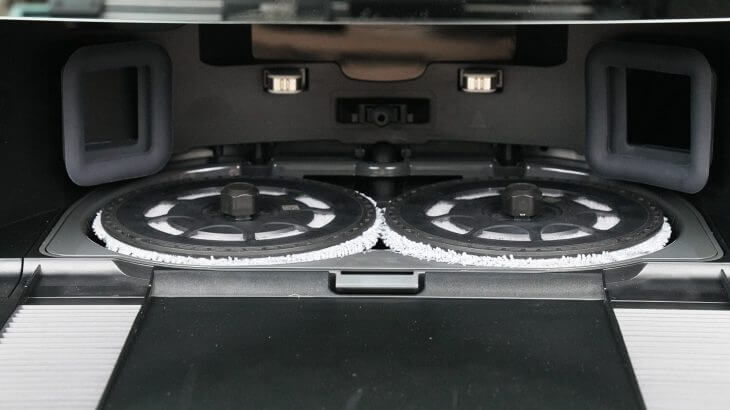
And the lifting of the body deserves special attention. The entire body automatically raises when the robot detects high obstacles or medium-pile carpets. This allows the robot vacuum cleaner to cross thresholds up to 4 cm (1.57 inches) high. The technology is called AdaptLift.
As for the station, improvements have also been made. The design was completely changed — it’s glossy, which, in my opinion, isn’t the most practical, but it does look great. At this station, the Roborock Saros 10R automatically empties its dustbin, washes the mop[ing pads with hot water, dries them with warm air, self-cleans the bottom of the station using scrapers, automatically mixes detergent, and pumps water into the robot’s tank.
Additionally, the station offers fast charging in just 2.5 hours and features an automatic wipe-soiling detection system that rewashes them if necessary. As per tradition, Roborock also provides a separate low-profile station that can connect to the sewer and water supply.
Now, let’s break down each component of the station. The robot’s entry ramp is removable. The tray for washing the cloths is also removable and consists of a modular insert with ridges for scrubbing, a main tray with scrapers, and a coarse filter for dirty water, which captures larger dirt. Notably, the station self-cleans the tray using hot water heated to a record 80°C (176°F). The cloths themselves are also washed at this temperature. Once cleaning is complete, they are dried with air heated to 55°C (131°F).
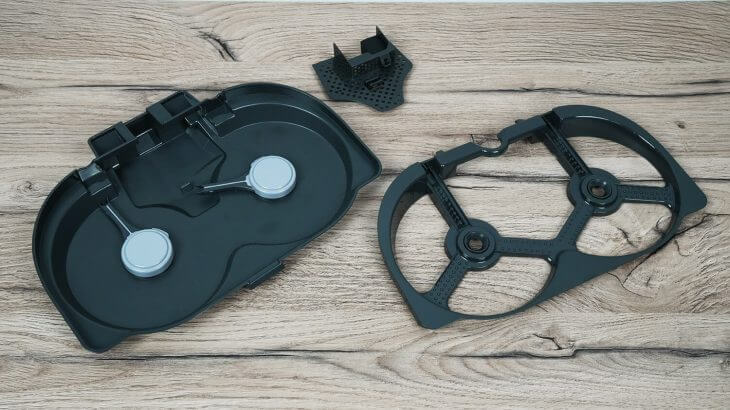
There is a trash bag in the front under the lid. It follows the usual design. Next to it is a tank for automatically adding detergent to the clean water — a feature that was noticeably missing in the Curv version! The capacity is 590 ml (19.96 oz).
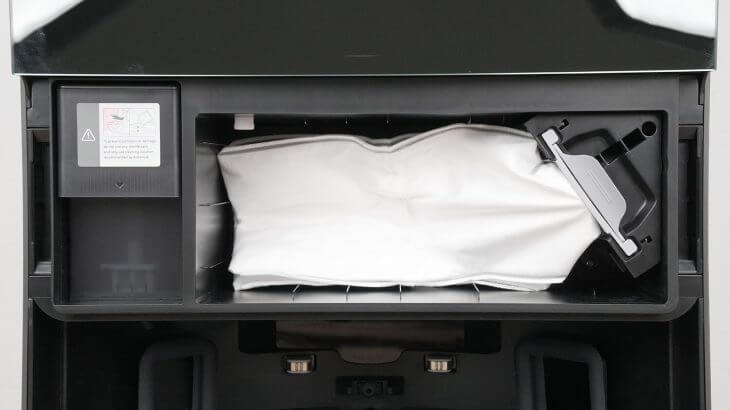
On top, there are two water tanks, both quite spacious at approximately 4 liters (1.06 gallons) each. The clean water tank also includes a cartridge for water disinfection.
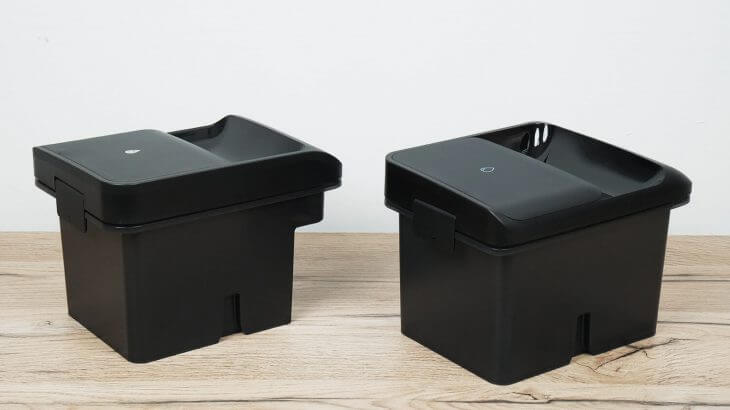
Overall, we can see that this new model comes with several updates compared to its predecessors. All the pros and cons of the design will be discussed when summarizing the results. Now, let’s move on!
Technical Features
The main specifications of the Roborock Saros 10R, as stated by the manufacturer:
Robot Vacuum Cleaner:
- Battery: 6400 mAh
- Suction power: up to 20,000 Pa
- Dust collector volume: ≈11.83 oz (350 ml)
- Water tank : ≈2.7 oz (80 ml)
- Obstacle clearance: up to 1.57 inches (40 mm)
- Robot dimensions: 13.9 x 3.15 inches (353 x 80 mm)
Station:
- Clean water tank: 1.06 gallons (4 l)
- Dirty water tank: 0.79 gallons (3 l)
- Bag in station: 0.66 gallons (2.5 l)
- Station dimensions: 15 x 18.7 x 19.2 inches (381 x 475 x 488 mm)
The suction power and the height of the housing have been updated. The other parameters remain unchanged.
Functionality
As for the functions, the robot vacuum cleaner is controlled through the proprietary Roborock app. The connection is simple and convenient.
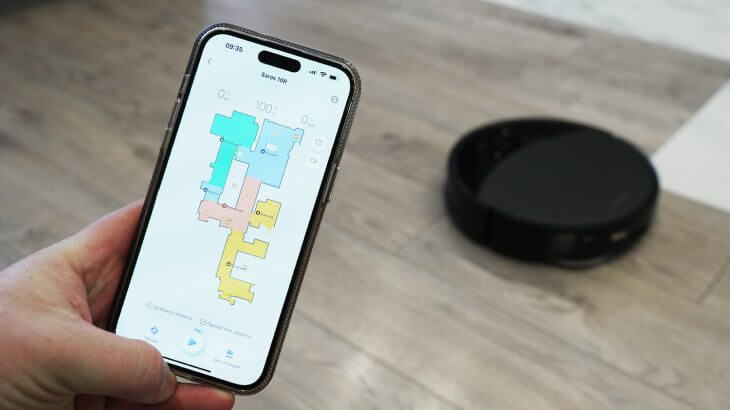
The main functions of the Roborock Saros 10R are displayed on the screen, with the color highlighting indicating the added features:
- Self-cleaning of the dust collector at the station.
- Washing the cloths at the station with hot water.
- Drying the cloths with warm air.
- Extension of the side brush in corners.
- Extension of the wipe holder to the baseboard.
- Refilling the water tank in the robot via the station.
- Automatic detergent replenishment.
- Removal of mopping pads at the station.
- Recognition of objects on the floor.
- Remote home tracking via camera.
- Saving multiple cleaning maps in memory.
- Automatic room zoning.
- Selection of zones and rooms for cleaning.
- Virtual walls and restricted areas (including for mopping mode).
- Adjustment of suction power.
- Adjustment of wipe wetness level.
- User mode.
- Cleaning log.
- Scheduling cleaning.
- Automatic power boost on carpets.
- Carpet bypass in mopping mode.
- Mopping pads lift when moving over carpets.
- Turbo brushes raised in wet mopping mode.
- Body lift when crossing obstacles.
- Hello Rocky support.
- Voice alerts in several languages.
The robot can be controlled using the “Hello Rocky” voice assistant. Just give the robot a voice command, and it does the job. No need for third-party devices – pretty awesome, right?
I’ll also point out that, in the lab features, there’s an option for the side brush to extend for more thorough sweeping in corners, but as of writing this review, it isn’t working yet. At least, in my case, the robot behaved as expected.
Overall, there are plenty of options for fine-tuning the cleaning settings to suit your specific needs. Definitely a plus!
Testing
Quick video review:
Navigation
Now, let’s get to testing! First off, we’ll check the navigation of the Roborock Saros 10R in a room with obstacles. The robot starts by navigating around a box, then tackles the room’s perimeter, and finally cleans the entire available area in a snake-like pattern. Due to the mirror, the navigation system created a non-existent room, which is a common issue with lidar-based robots. Even with the updated system that doesn’t rely on traditional lidar, this problem still occurs. The dryer’s legs didn’t cause any issues. The robot cleaned around the table legs, barely touching them, and then returned to the station. Test passed with flying colors.
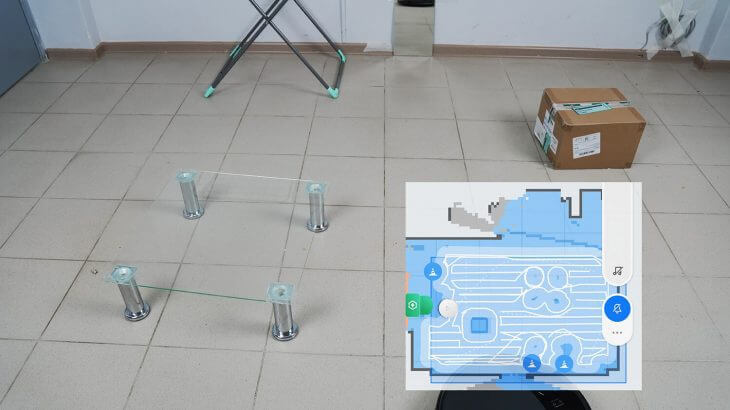
When it comes to navigating within the home, Roborock Saros 10R cleans room by room, starting from the perimeter and then following a snaking pattern. After each room or at set intervals, the robot returns to the station to rinse its cloths, then picks up where it left off. No messy areas left behind, cleaning speed is fast, and navigation is really solid with this model!
Going Under Low Furniture
I also checked the minimum height that Roborock Saros 10R can fit under. I managed to create a clearance of 83 mm (3.27 inches), and the robot slid right under without any issues. So, in reality, it should be able to go under furniture that’s up to 8 cm (3.15 inches) tall, as claimed in the marketing materials.
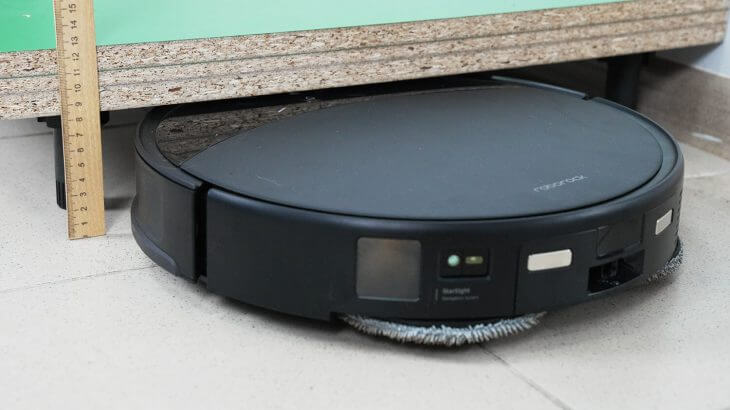
Autonomy
I separately checked how long the battery would last when the robot was running at max power with mopping enabled. It managed to work for 122 minutes, covering 88 square meters (947 square feet) of usable area. In real-world terms, that’s more than two complete cleanings of a 70 square meter (753 square feet) two-room apartment. There’s also a resume cleaning mode after the robot recharges at the base, which means this model is well-suited for cleaning large areas.
Object Recognition on the Floor
As for the object avoidance system, in good lighting conditions, the robot successfully recognized and carefully avoided 6 out of 6 objects on the floor. It also managed to neatly avoid 3 out of 3 socks, all 4 wires, and 6 out of 6 imitation pet surprises. Speaking of the last test, one of the traps got slightly snagged, but not critically.
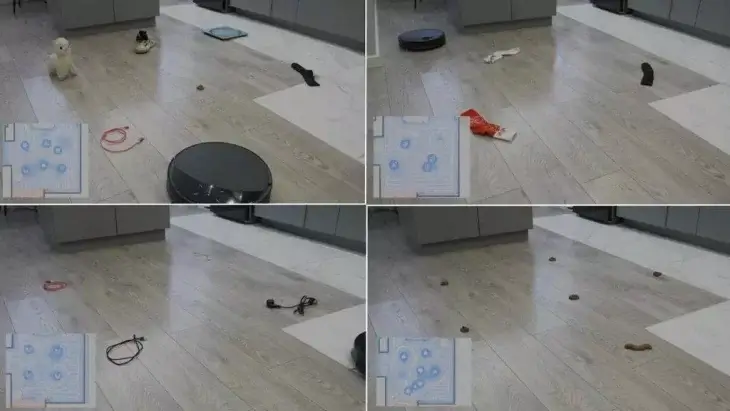
In total darkness, the detection system has some trouble, but it still performs fairly well. The robot bypassed 5 out of 6 standard objects, correctly recognizing 3 of them. It bypassed the toy but didn’t recognize it, recognized the shoes, but took a little longer to recognize the floor scales, and almost missed one before stopping. The imitation pet surprise was chewed up, while the sock was mistakenly recognized as a wire and didn’t bypass it. The wire was properly recognized and avoided. Interestingly, the robot correctly avoided 3 out of 4 wires on the floor, chewing on only the black one. It avoided 3 out of 3 socks, and the toughest challenge — bypassing the 3 out of 6 traps in the form of imitation excrement — was successful, recognizing one of them as paper.
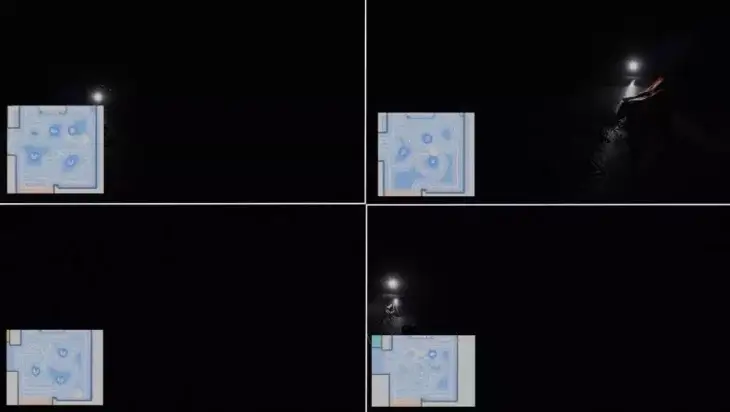
However, if we compare the location of traps before and after the test, we can see that the robot slightly moved all 6.
Overall, based on my experience, I can say the object recognition system is quite accurate—on par with similar models—but still has room for improvement. The engineers at Roborock have made progress compared to the Roborock Qrevo Curv, in my opinion, with better object recognition now.
Cleaning Behind Curtains
I also checked if the new navigation system allows cleaning behind curtains and drapes, which many lidar robots struggle with. Unfortunately, this robot can’t clean behind curtains, and neither can its fellow models in the lineup.
Suction power
The power test was the most interesting to me. In Silent mode, the Roborock Saros 10R cleaned dirt only from a 2 mm (0.08 in) gap. In Equilibrium mode, it partially cleaned a 4 mm (0.16 in) gap. In Turbo mode, the 4 mm (0.16 in) gap was cleaned a bit better. In max mode, the result stayed the same. In Max+ mode, the robot cleaned 6 and even 8 mm (0.24 and 0.31 in) deep crevices.
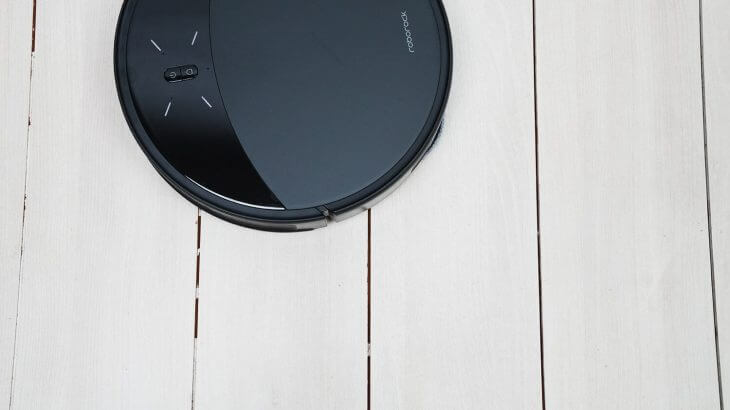
The suction power is the same as the Curv version—higher than the S8 line, but the 20,000 Pa is debatable. For example, the Roborock Qrevo S cleaned a 10 mm (0.39 in) slot at 7,000 Pa.
Aerodynamic losses remain an unresolved issue for Roborock engineers.
Vacuuming
The quality of dirt collection on laminate is good, but there’s a catch. In the first pass, the robot missed one of the corners. The second pass improved, and the third cleaned it completely, showing perfect vacuuming. I noticed the retractable side brush doesn’t always work correctly.

Sometimes, it doesn’t fully sweep out dirt and hides in the housing. I tested it with and without the recognition system, adjusting the sensitivity of object detection. When the algorithm works well, the side brush handles corners perfectly. This issue will likely be fixed in future firmware updates.
I also checked how the robot vacuum cleaner sweeps the outside corners. In 3 passes, I think it did a good job, leaving only a minimal amount near the outside corner. Further reviews will compare how other models handle this task.
I’ll note that the center and side brushes remain clean. Kudos to the Roborock engineers! The test was a success.

Carpet cleaning
Carpet cleaning is a bit nuanced. The Roborock Saros 10R cleans low-pile carpet well while the side brush rotates. For medium-pile carpets, it also works well after a few passes. The issue, however, is that on medium-pile carpets, the side brush is automatically lifted, and this feature cannot be turned off. As a result, carpets are cleaned worse without the side brush.
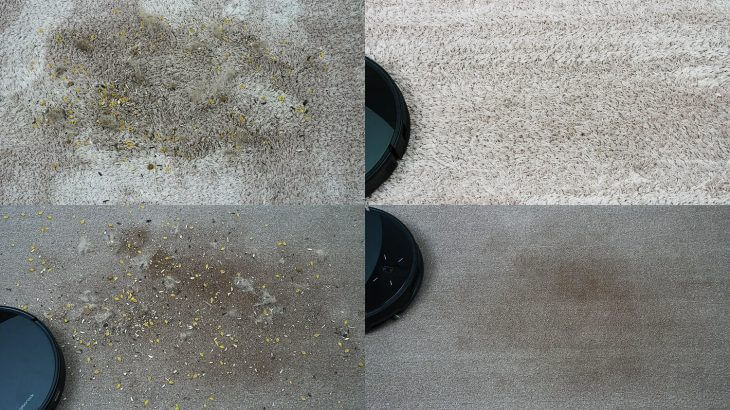
The bigger problem is if the carpet is placed close to the baseboard or furniture — it he narrow area won’t be cleaned. Since the side brush doesn’t work here and the center brush doesn’t reach the edge of the body. This should definitely be fixed by adding a function to manually disable the side brush lift!
Self-cleaning
Immediately after the “dirty tests,” I checked how well the robot vacuum cleaner cleans itself. The dust bag was tightly packed. We returned the robot to the station and started self-cleaning. The result was good. The dust collector was completely cleaned. The test was successful!
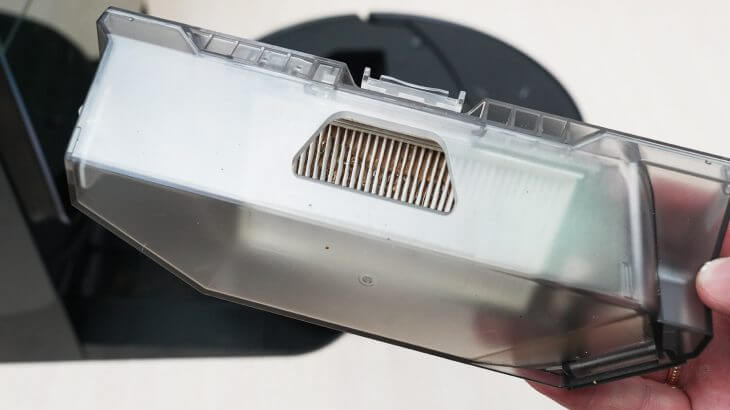
Mopping and carpets
As for mopping in the presence of carpets, there are several ways the robot interacts with carpets. It can gently drive around them in mopping mode, or it can make contact with the carpet if you want the robot to clean the carpet in some way. The robot can clean carpets in mopping mode, automatically lifting the cloths and even the body when driving over carpets. It can also automatically remove the cloths at the station and clean the carpets without them, which completely eliminates the contact of wet cloths with the carpet pile. The last two options are the most rational.
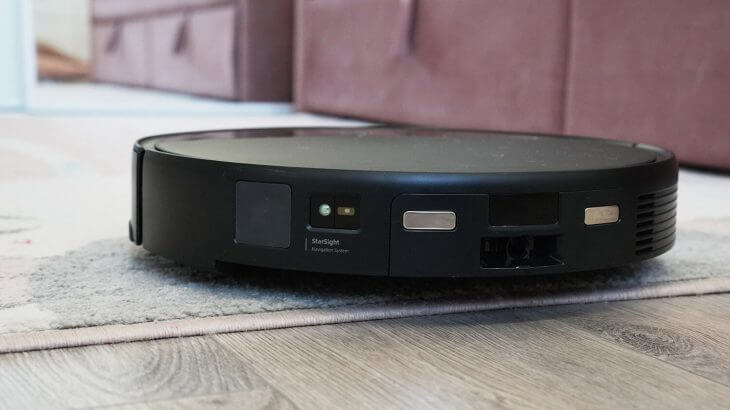
Dirt scrubbing
The quality of scrubbing is high. The cloths press well against the floor and absorb the dirt, leaving no narrow area along the baseboard, thanks to one of the cloths reaching the baseboard. That’s a plus!

I also checked the blind spot along the outer and inner corners separately. We can see that the outer corner is not completely cleaned. There’s a small blind spot less than 1 cm wide. In the inner corners, the blind spot is about 3 cm because the round cloth physically cannot reach tightly into the corner.

Scrubbing difficult stains
As for scrubbing difficult stains, the robot was able to scrub even dried coffee and sauce stains. Not the first time, though—by the sixth attempt, it was completely clean. In my opinion, this is the best result in the Roborock line and the best compared to similar models I’ve reviewed. And the detergent wasn’t even used, as it wasn’t in the kit. The test passed successfully!

Washing quality of mopping pads
Now, let’s talk about the station’s efficiency. First up, the quality of the napkin washing. Even after the tough tests, the napkins looked much better after washing at the station. The water heating function certainly boosts the washing efficiency. The cloths are very hot when they leave the station. After washing the floor, the cloths rinse well at the station, with dirt not being left behind due to the warm water pressure. That’s a plus!
The drying of cloths is also effective. They are completely dried at the station, thanks to warm air drying.
Station maintenance
As for station maintenance, the drip tray requires almost no intervention. The bottom stays clean due to the self-cleaning function of the scrapers with hot water rinsing. After a week of use, I only found a small amount of hair left behind on the filter. But everything is conveniently removed, rinsed, and put back in.
Obstacles
An interesting point about passing thresholds: the Roborock Saros 10R has no issue going over a 2 cm (0.8 in) threshold, which is expected. However, the robot struggles to cross a 3 cm (1.2 in) threshold.
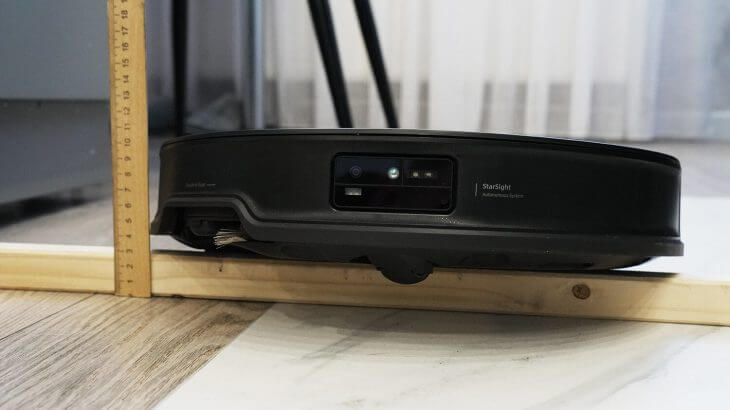
When attempting to pass a 4 cm (1.6 in) threshold, no matter the angle or effort, the robot couldn’t move forward. This issue was also observed in the Curv-version. So while the passability of this new model is impressive and among the best for robot vacuum cleaners, I can’t confirm it can pass a 4 cm (1.6 in) threshold.

Going over dark areas
There are no problems with driving over black carpeting. The robot goes over black carpets without any issues.
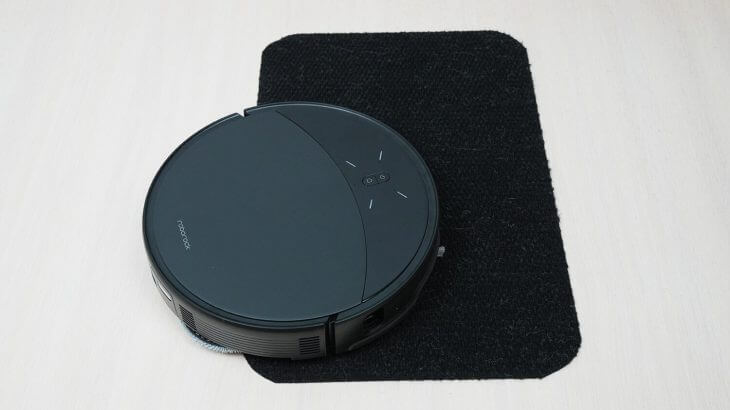
Volume
Regarding the volume, the noise level ranges from 58 to 66.8 dB depending on the selected mode. The noise level is notably low, especially when considering the increased suction power. The station’s noise level when self-cleaning is about 72 dB, which is also a good result.
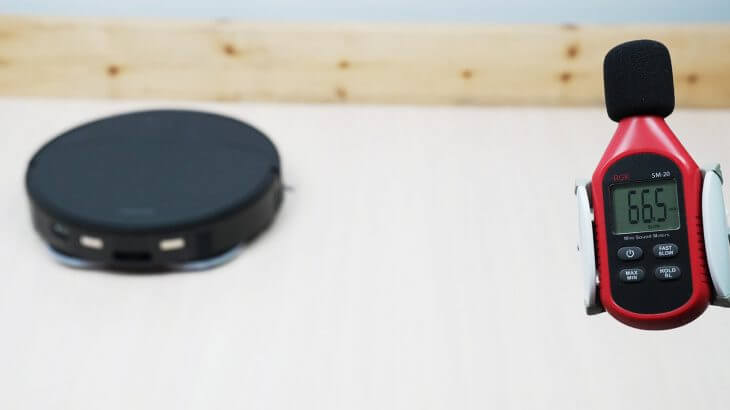
Opinion
The Roborock Saros 10R robot vacuum cleaner was thoroughly reviewed and tested. Based on our evaluation system, it earned 237 points, coming close to the leader in the ranking, the DreameBot X40 Ultra Complete. I didn’t deduct points for some of the shortcomings, which I hope will be addressed in future firmware updates. The robot was just shy of topping the overall rating due to a few small issues.
Overall rating of the tested robots: https://robotobzor.com/ratings/general-rating-of-robot-vacuum-cleaners.html.
Now, let’s go over the advantages. Here’s what I liked:
Pros:
- The robot is lower than lidar models, without compromising navigation. It can go where robots with a tower-shaped lidar on the body cannot.
- Backlit object recognition system that works effectively in good light.
- An all-in-one station for self-cleaning the dust bag, washing, and drying cloths.
- High efficiency of the updated station. Self-cleaning from trash, washing napkins with very hot water, full drying with warm air, scrapers in the tray simplifying maintenance, spacious tanks, and an autodispenser of detergent.
- The side and center brushes don’t wrap around hair and fur, thanks to the updated design.
- Improved walkability due to the lifting of the body. The robot vacuum cleaner can overcome thresholds higher than 3 cm (1.18 inches), which other robots on the market cannot.
- The retractable side brush completely sweeps out dirt in corners.
- Exit wipe close to the baseboard.
- Lifting cloths when driving onto carpets.
- Automatic removal of cloths at the station.
- Turbo brush lift in mopping mode.
- Increased suction power.
- Quality dry and mopping on different surfaces.
- Able to scrub even complex contaminants faster than analogs.
- A large number of functions in the application.
- Remote tracking of the house when connected to the robot camera via smartphone.
- Control via Hello Rocky proprietary voice assistant.
- Robot vacuum cleaner is not afraid of black coatings.
- Low noise level of both the robot and the station.
- Quality assembly and high brand credibility.
- Availability of warranty and service.
Cons:
- The station in the version that came for review cannot be connected to the sewer and water supply.
- The robot vacuum cleaner does not clean behind curtains and drapes.
- There are still some power losses, though less than before.
- The side brush rises on carpets, and this function cannot be turned off. As a result, if the carpet is close to the wall, the area along the wall will not be swept by the side brush.
- The algorithm of the side brush moving out in corners needs improvement, as it does not always function correctly. Sometimes it comes back in without sweeping.
- The object recognition system is a little blind in the dark, requiring improvement.
- The robot vacuum cleaner could not overcome a 4 cm (1.57 inches) threshold, despite it being claimed to have that passability. Even 3 cm (1.18 inches) is a challenge.
As a result, even the presence of a sewer connection module would make this robot vacuum cleaner the best in early 2025 according to the Robotobzor project. And also add cleaning behind curtains and work on the power – and the gap would be serious, comparing with the main competitor.
Nevertheless, Roborock Saros 10R is truly an autonomous, efficient, easy-to-use, and most importantly, reliable robot vacuum cleaner, as it is produced by a very well-known brand, and the build quality is actually good. It is also an underrated off-roader in the robot vacuum cleaner market, vastly superior to analogs if this point is important to you. Therefore, it is unequivocally recommended for purchase and unequivocally deserves attention!
Amazon: https://amzn.to/3R1qjWB
On this note, I’d like to end the review. If you still have any questions, feel free to leave them in the comments down below. Have fun shopping, bye!

